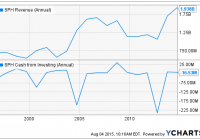Suburban Propane Partners Q4 Earnings Review: Good Performance Despite Higher Losses
Summary Operating loss increased from $34 million to $48 million. Integration costs and pension charges skewed results. Earnings should improve once these charges are eliminated. It’s been a week since Suburban Propane Partners (NYSE: SPH ) reported Q4 earnings, and the market remained neutral. Despite declining revenue and $48 million in operating loss, I believe that results were fantastic. Let me tell you why. As with many other natural gas related companies, sales suffered, dropping from $241 million to $174 million. The difference between this revenue decline and say a midstream company with POP contracts is that a lot of the company’s costs are variable. As the result of lower commodity prices, the company was actually able to increase the gross margin from 50% last year to 67%. This is a phenomenon that is common among refiners as well. What about the net loss? After all, the company did report an operating loss of $48 million. I would like to remind readers that the propane business is highly seasonal, and losses during warmer months are expected. (see below) As mentioned in my previous article , the company sells around two-thirds of retail volume from October to March, so the goal during hotter months is really to minimize loss. Unfortunately, the company does not seem to have accomplished that goal, as Q4’s operating loss of $48 million was higher than Q4 2014’s loss by 39%. However, there were multiple one-time costs that hurt Q4 results. First there is the integration cost. As mentioned in the previous article, the company acquired Inergy in 2012, and the integration process was still in progress in Q4 2015. During the quarter, the company spent $6.4 million on integration costs versus $3.2 million last year. This may be alarming since it would appear that integration costs are ramping up as opposed to going down. However, the management stated that the integration process was essentially complete, leading me to believe to that this cost increase is related to the “final push” as the company wraps up everything. Going forward, I expect integration costs to decline significantly or be eliminated. In addition to the integration costs, the company also had two pension related charges. First there was $11.3 million relating to the company’s partial withdrawal from a pension plan covering some former Inergy employees, which will save the company money later. If we account for these one-time charges, operating loss would actually decrease $30 million, which would be a 3% improvement from Q4 2014’s adjusted loss of $31 million. Keep in mind that the company was able to achieve this result despite the warmer weathers that we’ve been experiencing. When we take the above factors into consideration, I think it’s clear that the company’s Q4 performance was very impressive. Takeaway Despite mounting losses, I believe that the company had a great quarter when we take one-time factors into account. When you invest in Suburban Propane Partners, there is always the risk of warmer weather. Unfortunately that is what we’ve experienced in Q4, but that is what makes Q4 performance even more impressive. Overall, I believe that the company will improve earnings going forward as it gets rid of the one-time charges.
